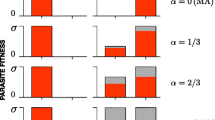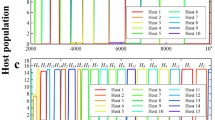Abstract
Host-parasite co-evolution is a key component of the Red Queen Hypothesis (RQH). The RQH currently being one of the main hypotheses describing the evolution of sex and recombination. However, most analyses in this area have either ignored parasite transmission or included it either with mean field or simple frequency based models. Moreover models have rarely addressed the issue of male haploid species. We here use agent based models to qualify the interactions between host- and parasite-based transmission parameters and virulence comparing diploid with male-haploid species. We found diploid hosts to have a higher fitness under the inverse matching allele mode compared to male haplodiploid hosts which in turn have a higher fitness under the matching allele model . Selection for recombination was rare but whenever selection for recombination was evident (<6.6 %), the resulting recombination rates were both consistently higher and more frequent in male haploids.






Similar content being viewed by others
References
Agrawal A, Lively C (2002) Infection genetics: gene-for-gene versus matching-alleles models and points in between. Evol Ecol Res 4:79–80
Agrawal A, Otto S (2006) Host-parasite coevolution and selection on sex through the effects of segregation. Am Nat 168(5):617–629
Agrawal AF (2009) Differences between selection on sex versus recombination in red queen models with diploid hosts. Evolution 63(8):2131–2141
Ames G, George D, Hampson C, Kanarek A, McBee C, Lockwood D, Achter J, Webb C (2011) Using network properties to predict disease dynamics on human contact networks. Proc R Soc B 278:3544–3550
Barton N (1995) A general model for the evolution of recombination. Genet Res 65:123–144
Boots M, Mealor M (2007) Local interactions select for lower pathogen infectivity. Science 315:1284–1286
Carroll L (1960) 2 The garden of live flowers. Through the looking-glass and what alice found there (The Annotated Alice: Alice’s Adventures in Wonderland and Through the Looking-Glass, illustrated by John Tenniel, with an Introduction and Notes by Martin Gardner ed.). The New American Library, New York
Crawley M (2005) Statistics: an introduction using R. Wily, West Sussex
Engelstädter J, Bonhoeffer S (2009) Red queen dynamics with non-standard fitness interactions. PLOS Comput Biol 5(e1000):469
Hodgeson E, Otto S (2012) The red queen coupled with directional selection favours the evolution of sex. J Evol Biol 25:797–802
Jäger I, Schjorring S (2006) Multiple infections: Relatedness and time between infections affect the establishment and growth of the cestode schistocephalus solidus in its stickleback host. Evolution 60(3):616–622
Keeling M (1999) The effects of local spatial structure on epidemiological invasions. Proc R Soc B 266:859–867
Kidner J, Moritz R (2013) The red queen process does not select for high recombination rates in haplodiploid hosts. Evol Biol 40(3):377–384
King K, Seppälä O, Neiman M (2012) Is more better? Polyploidy and parasite resistance. Biol Lett 8:598–600
Lively C (2010) An epidemiological model of host-parasite coevolution and sex. J Evol Biol 23:1490–1497
Meznar E, Gadau J, Koeniger N, Rueppell O (2010) Comparative linkage mapping suggests a high recombination rate in all honeybees. J Hered 101:s118–s126
M’Gonigle L, Otto S (2011) Ploidy and the evolution of parasitism. Proc R Soc B 278:2814–2822
Normark BB (2003) The evolution of alternative genetic systems in insects. Annu Rev Entomol 48:397–423
Nuismer S, Otto S (2004) Host-parasite interactions and the evolution of ploidy. PNAS 101:11,036–11,039
Oswald B, Nuismer S (2007) Neopolyploidy and pathogen resistance. Proc R Soc B 274:2393–2397
Otterstatter MC, Thomson JD (2007) Contact networks and transmission of an intestinal pathogen in bumble bee ( Bombus impatiens) colonies. Oecologia 154:411–421
Otto S, Marks J (1996) Mating systems and the evolutionary transition between haploidy and diploidy. Biol J Linn Soc 57:197–218
Otto S, Nuismer S (2004) Species interactions and the evolution of sex. Science 304:1018
Peters A, Lively C (1999) The red queen and fluctuating epistasis: a population genetic analysis of antagonistic coevolution. Am Nat 154:393–405
Peters A, Lively C (2007) Short- and long-term benefits and detriments to recombination under antagonistic coevolution. J Evol Biol 20:1206–1217
Popp M, Erler S, Lattorf HMG (2012) Seasonal variability of prevalence and occurrence of multiple infections shape the population structure of crithidia bombi, an intestinal parasite of bumblebees ( bombus spp.). MicrobioligyOpen 1(4):362–372
R Core Team (2013) R: a language and environment for statistical computing. R Fundation for Statistical Computing, Vienna, Austria. http://www.R-project.org
Roode JD, Yates A, Altizer S (2008) Virulence-transmission trade-offs and population divergence in virulence in a naturally occuring butterfly parasite. Proc Nat Acad Sci USA 105:7489–7494
Salathé M, Kouyos R, Regoes R, Bonhoeffer S (2007) Rapid parasite adaptation drives selection for high recombination rates. Evolution 62:295–300
Schjorring S, Koella JC (2003) Sub-lethal effects of pathogens can lead to the evolution of lower virulence in multiple infections. Proc R Soc Lond Ser B 270(1511):189–193
Schmid-Hempel P, Jokela J (2002) Socially structured populations and evolution of recombination under antagonistic coevolution. Am Nat 160(3):403–408
Shykoff J, Schmid-Hempel P (1991) Incidence and effects of four parasites in natural populations of bumble bees in switzerland. Apidologie 22:117–125
Stolle E, Wilfert L, Schmid-Hempel R, Schmid-Hempel P, Kube M, Reinhardt R, Moritz R (2011) A second generation genetic map of the bumblebee bombus terrestris (linnaeus, 1758) reveals slow genome and chromosome evolution in the apidae. BMC Genom 12:48
Sutton J, Nakagawa S, Robertson B, Jamieson I (2011) Disentangling the roles of natural selection and genetic drift in shaping variation at mhc immunity genes. Mol Ecol 20:4408–4420
Takahashi Y, Morita S, Yoshimura J, Watanabe M (2011) A geographic cline induced by negative frequency-dependent selection. BMC Evol Biol 11:256–266
Webb S, Keeling M, Boots M (2013) A theoretical study of the role of spatial population structure in the evolution of parasite virulence. Theor Popul Biol 84:36–45
Wilfert L, Gadau J, Schmid-Hempel P (2007) The genetic architecture of immune defense and reproduction in male bombus terrestris bumblebees. Evolution 61:804–815
Williams T, Kelly C (2003) GNUPLOT: an interactive plotting program. http://www.gnuplot.info
Acknowledgments
Funding for the research was provided by the Deutsche Forschungsgemeinschaft within the priority program SPP 1399 and by yDiv, the Synthesis Centre for Biodiversity Sciences—a unit of the German Centre for Integrative Biodiversity Research (iDiv) Halle-Jena-Leipzig, also funded by the Deutsche Forschunggemeinschaft (FZT 118).
Author information
Authors and Affiliations
Corresponding author
Electronic supplementary material
Below is the link to the electronic supplementary material.
Rights and permissions
About this article
Cite this article
Kidner, J., Moritz, R.F.A. Host-parasite evolution in male-haploid hosts: an individual based network model. Evol Ecol 29, 93–105 (2015). https://doi.org/10.1007/s10682-014-9722-y
Received:
Accepted:
Published:
Issue Date:
DOI: https://doi.org/10.1007/s10682-014-9722-y




